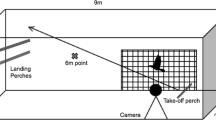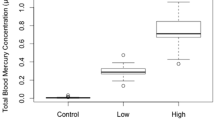Abstract
Long-term, sublethal methylmercury exposure can cause reproductive depression, immune suppression, endocrine disruption and other problems in birds. We used two biomarkers to detect oxidative stress in livers of zebra finches (Taeniopygia guttata) developmentally exposed to sublethal levels of dietary methylmercury (0.0, 0.3, 0.6, 1.2, or 2.4 μg/g wet weight in diet). Our findings indicate that young adult finches exposed to environmentally relevant concentrations of mercury in ovo and through their diets, exhibited oxidative stress in their livers. We measured the ratio of the antioxidant glutathione in its reduced form (GSH) versus its oxidized form (GSSG) and the activity of the superoxide dismutase (SOD) enzyme suite. Blood total mercury served as a proxy for liver mercury concentration, and was on average 8.4 times the dietary dose (e.g., birds consuming 0.6 μg/g had blood mercury levels of ~5 μg/g on a wet weight basis). Consistent with what is known from large, aquatic bird species, there was a significant, negative relationship between GSH/GSSG ratios and tissue mercury concentrations, which is indicative of oxidative stress. This relationship was driven by a significant increase in the oxidized glutathione in the livers of birds with higher blood mercury levels. SOD activity was also found to have a significant, negative relationship with blood mercury.



Similar content being viewed by others
References
Cristol DA, Brasso RL, Condon AM, Fovargue RE, Friedman SL et al (2008) The movement of aquatic mercury through terrestrial food webs. Science 320:335. doi:10.1126/science.1154082
Custer TW, Hines RK, Melancon MJ, Hoffman DJ, Wickliffe JK et al (1997) Contaminant concentrations and biomarker response in great blue heron eggs from 10 colonies on the upper Mississippi River, USA. Environ Toxicol Chem 16:260–271. doi:10.1002/etc.5620160223
Eisler R (2006) Mercury: hazards to living organisms. CRC: Taylor and Francis, Boca Raton
Ercal N, Gurer-Orhan H, Aykin-Burns N (2001) Toxic metals and oxidative stress part I: mechanisms involved in metal-induced oxidative damage. Curr Top Med Chem 1:529–539. doi:10.2174/1568026013394831
Frederick PC, Spalding MG, Dusek R (2002) Wading birds as bioindicators of mercury contamination in Florida, USA: annual and geographic variation. Environ Toxicol Chem 21:163–167. doi:10.1002/etc.5620210123
Gutteridge JM (1995) Lipid peroxidation and antioxidants as biomarkers of tissue damage. Clin Chem 41:1819–1828
Hallinger KK, Zabransky DJ, Kazmer KA, Cristol DA (2010) Song differs between birds on mercury-polluted and reference sites. Auk 127:156–161. doi:10.1525/auk.2009.09058
Hawley DM, Hallinger KK, Cristol DA (2009) Compromised immune competence in free-living tree swallows exposed to mercury. Ecotoxicology 18:499–503. doi:10.1007/s10646-009-0307-4
Heinz GH, Hoffman DJ, Klimstra JD, Stebbins KR (2010) Reproduction in mallards exposed to dietary concentrations of methylmercury. Ecotoxicology 19:977–982. doi:10.1007/s10646-010-0479-y
Henny CJ, Hill EF, Hoffman DJ, Spalding MG, Grove RA (2002) Nineteenth century mercury: hazard to wading birds and cormorants of the Carson River, Nevada. Ecotoxicology 11:213–231. doi:10.1023/A:1016327602656
Hoffman DJ, Heinz GH (1998) Effects of mercury and selenium on glutathione metabolism and oxidative stress in mallard ducks. Environ Toxicol Chem 17:161–166. doi:10.1002/etc.5620170204
Hoffman DJ, Ohlendorf HM, Marn CM, Pendleton GW (1998) Association of mercury and selenium with altered glutathione metabolism and oxidative stress in diving ducks from the San Francisco bay region, USA. Environ Toxicol Chem 17:167–172. doi:10.1002/etc.5620170205
Hoffman DJ, Spalding MG, Frederick PC (2005) Subchronic effects of methylmercury on plasma and organ biochemistries in great egret nestlings. Environ Toxicol Chem 24:3078–3084. doi:10.1897/04-570.1
Hoffman DJ, Eagles-Smith CA, Ackerman JT, Adelsbach TL, Preston KR (2011) Oxidative stress response of Forster's terns (Sterna forsteri) and caspian terns (Hydroprogne caspia) to mercury and selenium bioaccumulation in liver, kidney, and brain. Environ Toxicol Chem 30:920–929. doi:10.1002/etc.459
Keller RH, Xie L, Buchwalter DB, Franzreb KE, Simons TR (2014) Mercury bioaccumulation in Southern Appalachian birds, assessed through feather concentrations. Ecotoxicology 23:304–316. doi:10.1007/s10646-013-1174-6
Kenow KP, Hoffman DJ, Hines RK, Meyer MW, Bickham JW et al (2008) Effects of methylmercury exposure on glutathione metabolism, oxidative stress, and chromosomal damage in captive-reared common loon (Gavia immer) chicks. Environ Pollut 156:732–738. doi:10.1016/j.envpol.2008.06.009
Lewis CA, Cristol DA, Swaddle JP, Varian-Ramos CW, Zwollo P (2013) Decreased immune response in zebra finches exposed to sublethal doses of mercury. Arch Environ Contam Toxicol 64:327–336. doi:10.1007/500244-012-9830-2
McCord JM, Fridovich I (1969) Superoxide dismutase an enzymic function for erythrocuprein (hemocuprein). J Biol Chem 244:6049–6055
McCord JM, Keele BB, Fridovich I (1971) An enzyme-based theory of obligate anaerobiosis: the physiological function of superoxide dismutase. Proc Natl Acad Sci USA 68:1024–1027
Moore CS, Cristol DA, Maddux SL, Varian-Ramos CW, Bradley EL (2014) Lifelong exposure to methylmercury disrupts stress-induced corticosterone response in zebra finches (Taeniopygia guttata). Environ Toxicol Chem 33:1072–1076. doi:10.1002/etc.2521
Singer MB, Aalto R, James LA, Kilham NE, Higson JL, Ghoshal S (2013) Enduring legacy of a toxic fan via episodic redistribution of California gold mining debris. Proc Natl Acad Sci USA 110:18436–18441. doi:10.1073/pnas.1302295110
Townsend DM, Tew KD, Tapiero H (2003) The importance of glutathione in human disease. Biomed Pharmacother 57:145–155. doi:10.1016/s0753-3322(03)00043-x
Townsend JM, Rimmer CC, Driscoll CT, McFarland KP, Iñigo-Elias E (2013) Mercury concentrations in tropical resident and migrant songbirds in Hispaniola. Ecotoxicology 22:86–93. doi:10.1007/s10646-012-1005-1
Valko M, Leibfritz D, Moncol J, Cronin MT, Mazur M, Telser J (2007) Free radicals and antioxidants in normal physiological functions and human disease. Int J Biochem Cell Biol 39:44–84. doi:10.1016/j.biocel.2006.07.001
Varian-Ramos CW, Condon AM, Hallinger KK, Carlson-Drexler KA, Cristol DA (2011) Stability of mercury concentrations in frozen avian blood samples. Bull Environ Contam Toxicol 86:159–162. doi:10.1007/s00128-010-0164-0
Varian-Ramos CW, Swaddle JP, Cristol DA (2014) Mercury reduces avian reproductive success and imposes selection: an experimental study with adult- or lifetime-exposure in zebra finch. PLoS ONE 9:e95674. doi:10.1371/journal.pone.0095674
Wada H, Cristol DA, McNabb FMA, Hopkins WA (2009) Suppressed adrenocortical responses and thyroid hormone levels in birds near a mercury-contaminated river. Environ Sci Technol 43:6031–6038. doi:10.1021/es803707f
Acknowledgments
This study was funded by E. I. DuPont de Nemours and Company and completed with oversight from the South River Science Team, which is a collaboration of state and federal agencies, academic institutions and environmental interests. Additional funding was provided by the Howard Hughes Medical Institute Undergraduate Science Education Program grant and a Llanslo-Sherman award from the Department of Biology at the College of William and Mary to KAH.
Conflict of interest
The authors declare that they have no conflict of interest.
Author information
Authors and Affiliations
Corresponding author
Additional information
The experiments conducted in this study were approved by the Institutional Animal Care and Use Committee (IACUC) of the College of William and Mary.
Rights and permissions
About this article
Cite this article
Henry, K.A., Cristol, D.A., Varian-Ramos, C.W. et al. Oxidative stress in songbirds exposed to dietary methylmercury. Ecotoxicology 24, 520–526 (2015). https://doi.org/10.1007/s10646-014-1400-x
Accepted:
Published:
Issue Date:
DOI: https://doi.org/10.1007/s10646-014-1400-x




